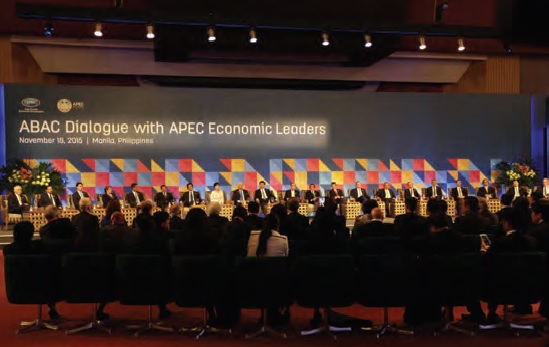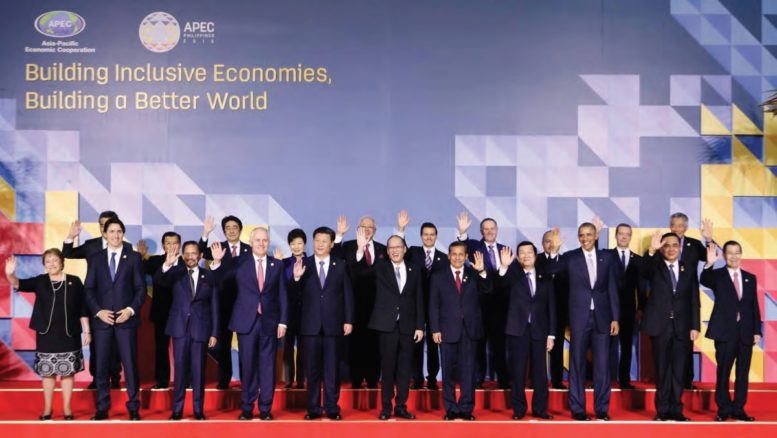In the shadows of today’s global problems – principal among them were terrorist attacks in Paris last 13 November that claimed 130 lives with others still in critical condition (and threats of more of the same in other countries in Europe and the U.S. by ISIS terrorists) – the Philippines hosted this week the 2015 Asia-Pacific Economic Cooperation (APEC) Leaders’ Meeting.
Against this complex backdrop of hope and apprehension, we recall the position paper FVR submitted at the Australia-APEC Community International Conference in Sydney last November 2009 organized by then Australia Prime Minister Kevin Rudd – a timely analysis that continues to be relevant in today’s troubled world.
During the Philippine Chairmanship of APEC in November 1996, the East Asian economies all seemed so robust that none realized we were standing on the brink of a financial disaster. But, in July 1997, the East Asian region had began to suffer what is nowknown as the “East Asian Financial Crisis.” The turmoil – which lasted up to 1999 and beyond for some economies – affected currencies, stock markets and economies in general in most Asian countries.
MANY BUSINESSES COLLAPSED AND, CONSEQUENTLY, THOUSANDS OF MIDDLECLASS PEOPLE FELL INTO POVERTY. INDONESIA, SOUTH KOREA AND THAILAND WERE THE ECONOMIES MOST ADVERSELY AFFECTED. HONGKONG, MALAYSIA, LAOS, AND THE PHILIPPINES WERE ALSO HIT – THOUGH NOT SO BADLY.
JAPAN, CHINA, CHINESE-TAIPEI, SINGAPORE, AND VIETNAM WERE RELATIVELY SECURE. BUT, THE CONTAGION RIPPLED THROUGHOUT THE GLOBE. ITS EFFECTS WERE FELT AS FAR AS RUSSIA, EASTERN EUROPE, THE UNITED STATES, AND BRAZIL.
Lessons From The East Asian Crisis
Every traumatic experience carries its lessons; and from the East Asian crisis, we learned the hard way that economic reforms that individual countries carried out – sometimes at great cost – were quite insufficient.
To restore investor confidence, deeper reforms were necessary – particularly the need to construct appropriate regulatory structures. Fortunately, the crisis – instead of setting off a wave of protectionism in East Asia – promoted further financial liberalization.
Significantly, APEC itself remained a leading force for trade liberalization throughout the crisis. At the 1997 Vancouver Summit, APEC Leaders agreed to designate 15 major sectors – especially automobiles, chemicals, energy, environmental conservation, medical equipment, and services – for earlier liberalization. Then, we also agreed that detailed plans would be required for eliminating trade and investment barriers in nine of these sectors, which involved over 1.5 trillion USD of global trade.
Looking back to that financial crisis from the perspective of these last 18 years, we can truly say that the Asia-Pacific’s faith in “Trade and Investments Liberalization and Facilitation (TILF)” paid off.
BUT IT IS NOT ONLY TILF THAT CONTRIBUTED TO THE GROWTH OF APEC MEMBERECONOMIES. APEC HAS ALSO ADDED TO ITS GROWTH MOMENTUM BY DEVELOPING “BEST-PRACTICES POLICIES” THROUGH ECONOMIC-TECHNICAL COOPERATION AND TEAM-BUILDING.
Expanding Cooperation To Include Security
APEC eventually broadened its agenda to include security issues, having realized that, in the real world, one cannot neatly separate economics from security. Hence – in October 2002 – the Leaders agreed to establish a “Secure Trade Area Region (STAR)” in APEC.
The STAR initiative aims to safeguard the flow of goods and people in the Asia-Pacific – through security measures that would protect ships and their cargo, international aviation, and people in transit. Such expanded cooperation consists of multilateral measures that enhance cross-border security, customs networking, and the protection of national and corporate supply chains.
In 2003 and 2004, APEC expanded its security mechanisms by creating the APEC Counter – Terrorism Task Force, and by contributing to the Asian Development Bank’s (ADB) “Regional Trade and Financial Security Initiative.” The APEC economies also tightened up domestic controls in Man-Portable Air Defense Systems (MANPADS) and countered money-laundering and terrorist financing schemes more effectively. To reduce the threat of regional epidemic diseases, APEC members also strengthened Asia-Pacific public health systems.
IN SUM, APEC’S TRACK RECORD ON SECURITY HAS BEEN COMMENDABLE. THE CONTINUING CHALLENGE IS TO KEEP SECURITY ARRANGEMENTS HARMONIZED, COMPREHENSIVE, AND RESPONSIVE TO ENSURE THAT ALL APEC ECONOMIES CONTINUE TO DO WELL AND PROVIDE A BOUNTIFUL FUTURE FOR ITS PEOPLES TO SHARE.

Photo Credit: APEC 2015 Philippines
Pax Asia Pacifica: Building An Asia-Pacific Community
OVER THE FORESEEABLE FUTURE, ALL OUR COUNTRIES MUST ACCEPT LIVING WITH A LARGER CHINESE PRESENCE. HOW, THEN, CAN LONG-TERM STABILITY IN THE ASIA-PACIFIC BE ENSURED? A SHIFT FROM PAX AMERICANA TO PAX ASIA-PACIFICA COULD WELL BE THE ANSWER.
We should exploit the convergence of interests that the U.S., Japan, China, India, ASEAN, a unified Korea, Russia, Australia, New Zealand, etc. have in a peaceful and stable Asia-Pacific – just as the Western Europeans exploited the Cold War stalemate between the U.S. and the U.S.S.R. to consolidate the European Union.
Under the “balance of terror” of the Cold War, Western Europe organized the economic, political, and cultural community that has now brought its peoples from their once-endless civil wars into the modern era of virtual “perpetual peace.”
Already the instruments have been laid for such ambitious goal. We have in ASEAN (now governed by a Charter) its Regional Forum (ARF) and the beginnings of larger Asian economic groupings – with an “ASEAN plus China, plus Japan, plus South Korea, plus India, plus Australia-New Zealand.”
Our APEC forum itself, linking 21 countries on both shores of the Pacific, provides a viable base on which to build a truly integrated Asia-Pacific community, more closely bonded not just by common economic interests but by shared security concerns, and most important, aspirations for a better future for all. Obviously, APEC economies and ASEAN-plus partners overlap considerably in terms of geography and populations.
Meanwhile, Asia-Pacific countries must cooperate more closely to prevent and pre-empt terrorist outbreaks in the region. And the key here is to devise strategies that would defeat terrorism without alienating the majority of Muslims living in our region because they are generally peace-loving, law-abiding, and responsible citizens.
IF THE POOR COUNTRIES ARE TO OVERCOME PROBLEMS OF ECONOMIC DEVELOPMENT AND POLITICAL MODERNIZATION, THEY MUST FIRST PUT THEIR HOUSES IN ORDER. ON THE OTHER HAND, THE RICH COUNTRIES MUST SHOULDER THE GREATER OBLIGATION TO MITIGATE THE IMPACT OF GLOBALIZATION – BY ENSURING THAT THE DEVELOPMENT WHICH INTERDEPENDENCE BRINGS DOES NOT LEAVE ANYONE BEHIND.
From The American To The Asia-Pacific Peace
Given the current favorable conditions for enhancing relations within APEC, it is timely for our leaders to consider the building of a new regional structure upon the larger principle of “human security” as already embraced by the United Nations.
Because of the constant threats of endemic diseases, natural calamities, environmental degradation, and international terrorism, not just “human development” but, indeed, “human security” has become mankind’s highest ambition.
In its home-region, APEC has a key role to play in creating a Pax Asia-Pacifica as the logical successor to the Pax Americana that has underpinned stability in the Asia-Pacific region for decades. Unlike the “American Peace” – which at bottom is enforced by U.S. military power – an “Asia-Pacific Peace” will be the peace of virtual equals, based on the concept of burden-sharing among all Asia-Pacific nations according to “best efforts.”
THE DESIRED OUTCOME IS A MULTI-NATIONAL MARITIME TASK FORCE SUPPORTED BY ALL ASIA-PACIFIC NATIONS (ESPECIALLY CHINA) TO ENSURE FREEDOM OF NAVIGATION, SAFETY OF LIFE AT SEA (SOLAS) AND TIGHTER MARITIME LAW ENFORCEMENT.
Already, APEC has broadened its agenda beyond trade and investment liberalization and economic growth. APEC’s 2002 STAR initiative – and its Anti-Terrorism Task Force – will be pivotal in ensuring the viability of the future Pax Asia-Pacifica.
Clearly, Pax Asia-Pacifica must be built on unswerving commitments to peace among the most powerful countries in our part of the world – namely, the U.S., China, Russia, and Japan.
A constructive Chinese role in organizing a Pax Asia – Pacifica would manifest China’s sincerity in being the “responsible stakeholder” Washington has challenged Beijing to become. Japan and Russia too must perform more security and peace-keeping participatory roles, if our region is to achieve Pax Asia-Pacifica.
ONE OF THE MOST CRITICAL FACTORS IN ENSURING PAX ASIA-PACIFICA, IN FACT, IS THE STRATEGIC RELATIONSHIP BETWEEN BEIJING AND TOKYO.
IN THE INTEREST OF REGIONAL PEACE, BOTH POWERS SHOULD STOP ALLOWING THEIR HISTORICAL RESENTMENTS TO DISRUPT THE ATTAINMENT OF A SECURE AND PROSPEROUS ASIA-PACIFIC FUTURE.
THE FUTURE: FROM APEC TO APECCS?
Is it not high time – seeing the mobility, destructiveness, and global reach of international terrorism exemplified last 13 November in France – that we move from APEC to Asia-Pacific Economic Cooperation, Community and Security? From APEC to APECCS? Or to use a more euphonious acronym, from APEC to APEX – which means from APEC to the summit/apex of HUMAN DEVELOPMENT, called HUMAN SECURITY?
IN THE END, THE RELATIONS AMONG THE ASIA-PACIFIC NATIONS SHOULD ALWAYS BE AN INTERPLAY OF COMPETITION AND COOPERATION.
THE STRATEGIC TEST FOR ALL NATION’S ECONOMIES – AND ALL THE REGIONAL ORGANIZATIONS SUCH AS APEC – IS TO ENSURE THAT THE SPIRIT OF COOPERATION TO PROSPER IS ALWAYS STRONGER THAN THE
COMPETITIVE IMPULSE TO DOMINATE.
WHATEVER BE OUR SHARED ENDEAVORS, WE MUST ENSURE THAT ALL THESE ARE UNDERTAKEN THROUGH SHARED VALUES, SHARED RESPONSIBILITIES, SHARED BURDENS, AND SHARED BENEFITS – TOWARD A HIGHER QUALITY OF LIFE FOR ALL.
HOW THINGS TURN OUT WILL, TO A GREAT EXTENT, DEPEND ON THE ACTIONS, DECISIONS, AND SPIRIT OF COMMUNITY EMERGING OUT OF OUR 2015 APEC MEETINGS IN THE PHILIPPINES.
CAN APEC INDEED BECOME THE APEX OF OUR ASPIRATIONS?
WHY NOT? KAYA NATIN ITO (YES, WE CAN) !!!
